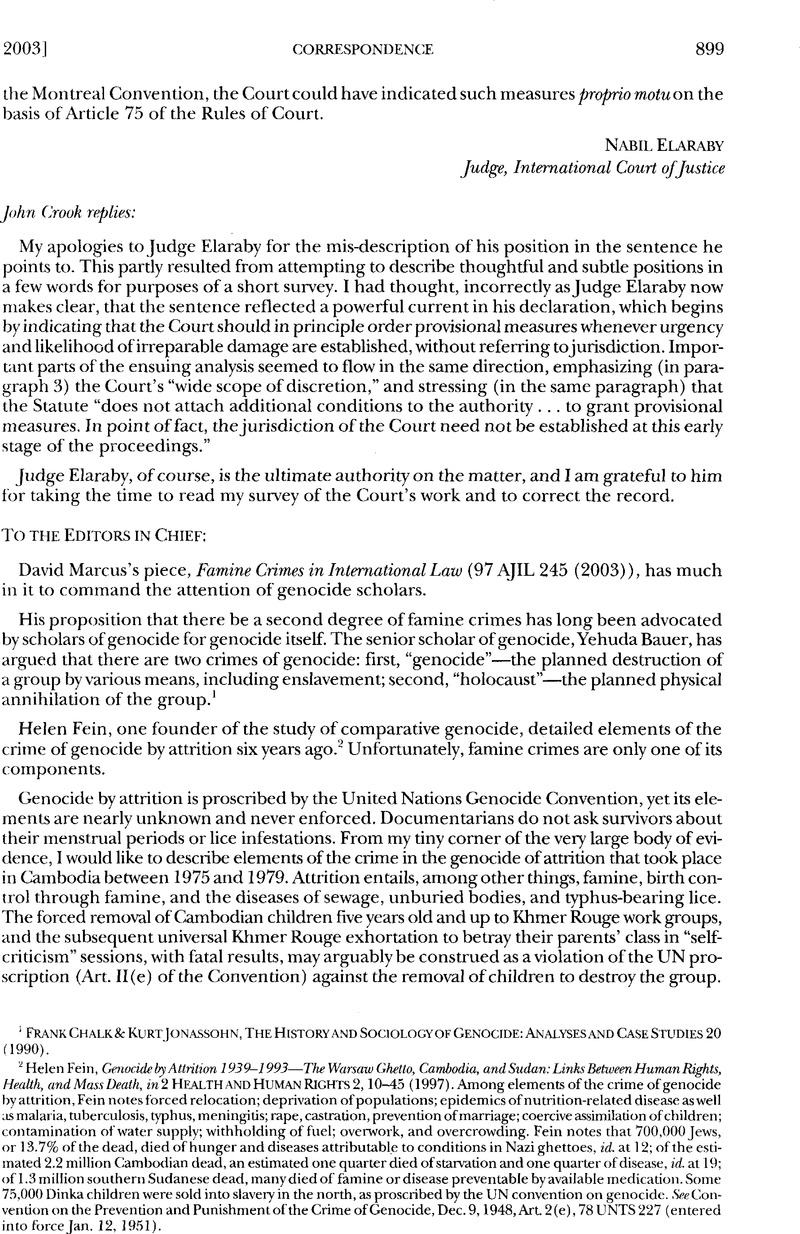No CrossRef data available.
Article contents
To the Editors in Chief
Published online by Cambridge University Press: 10 March 2017
Abstract

- Type
- Correspondence
- Information
- Copyright
- Copyright © American Society of International Law 2003
References
1 FRANK CHALK & KURTJONASSOHN, THE HISTORY AND SOCIOLOGY OF GENOCIDE: ANALYSES AND CASE STUDIES 20 (1990).
2 Helen Fein, Genocide by Attrition 1939-1993&—The Warsaw Ghetto, Cambodia, and Sudan: Links Between Human Rights, Health, and Mass Death, in 2 HEALTH AND HUMAN RIGHTS 2,10-45 (1997). Among elements of the crime of genocide by attrition, Fein notes forced relocation; deprivation of populations; epidemics of nutrition-related disease as well as malaria, tuberculosis, typhus, meningitis; rape, castration, prevention of marriage; coercive assimilation of children; contamination of water supply; withholding of fuel; overwork, and overcrowding. Fein notes that 700,000 Jews, or 13.7% of the dead, died of hunger and diseases attributable to conditions in Nazi ghettoes, id. at 12; of the estimated 2.2 million Cambodian dead, an estimated one quarter died of starvation and one quarter of disease, id. at 19; of 1.3 million southern Sudanese dead, many died of famine or disease preventable by available medication. Some 75,000 Dinka children were sold into slavery in the north, as proscribed by the UN convention on genocide. See Convention on the Prevention and Punishment of the Crime of Genocide, Dec. 9,1948, Art. 2 (e), 78 UNTS 227 (entered into force Jan. 12, 1951).
3 MAREK SLIWINSKI, LE GENOCIDE KHMER ROUGE: UNE ANALYSE DEMOGRAPHIQUE 82 (1995).
4 Judith Banister & Paige Johnson, After the Nightmare: The Population of Cambodia, m GENOCIDE AND DEMOCRACY IN CAMBODIA: THE KHMER ROUGE, THE UNITED NATIONS, AND THE INTERNATIONAL COMMUNITY 90 (Ben Kiernao ed., 1996).
5 BEN KIERNAN, THE POLPOT REGIME: RACE, POWER AND GENOCIDE IN CAMBODIA UNDKRTHE KHMER ROUGE, 1975-1979 236, n. 40, 380-82 (1996).
6 CRAIG ETGHESON, RETRIBUTION AND RECONCILIATION: HEALING WHAT AILS CAMBODIA (unpublished project report to the U.S. Institute of Peace, 2002).


